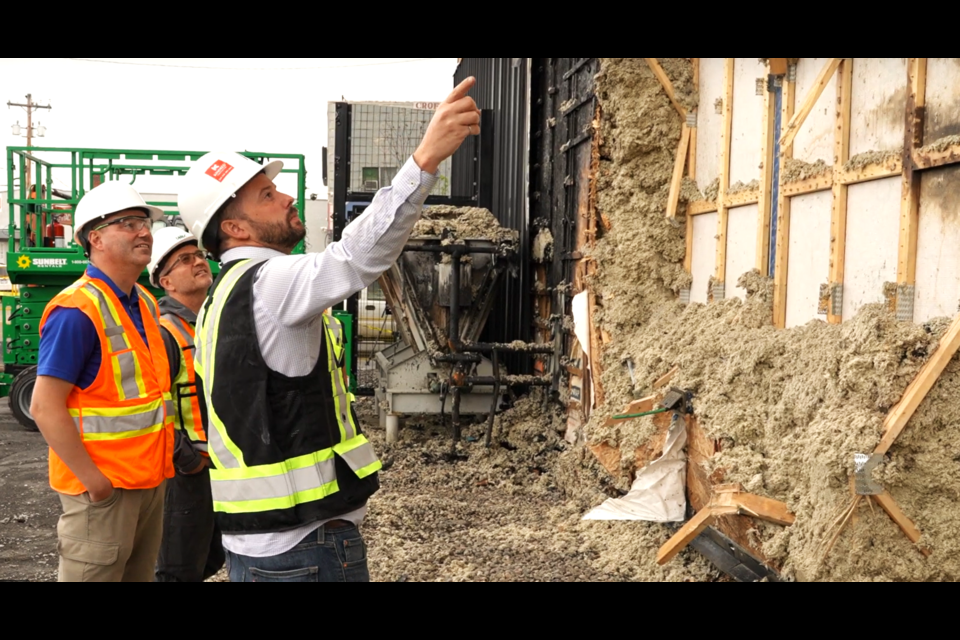The resiliency of wood construction was put to the test on Aug. 22, 2023.
On that morning in downtown Prince George, UNBC’s Wood Innovation Research Laboratory was in the wrong place at the wrong time when an adjacent building formerly known as the Achillion Restaurant exploded. The blast would later be blamed on people trying to steal copper ruptured a natural gas line that was subsequently ignited by a cigarette lighter.
The ensuing fireball injured three people and shot burning debris at lightning speed into the west-facing side of the wood innovation building with enough force to pierce the wall of the research lab, causing it to burst into flames.
Despite the violence of the explosion and heat from the fire, the state-of-the-art mass timber structure - built to airtight Passive House energy efficiency standards - bent but did not break, proving the flexibility and strength of the wood mechanics that went into its construction, the university reported.
“It’s pretty rare that you get to see a building that you designed go through something as extreme as an explosion next door,” said Adam Gerber, CEO/principal of Aspect Structural Engineers.
The building, which is beside the Wood Innovation and Design Centre, is used by UNBC students to test cutting-edge design advancements in wood construction technology.
How well it withstood the explosion, fire and flood from the triggered sprinkler system was an unplanned experiment that produced encouraging results.
“Overall, the building performed better than anyone could have predicted or expected based on the severity of the events that occurred," Gerber said.
The wall that bore the brunt of the massive pressure wave of an explosion strong enough to sway window curtains of suburban houses kilometres away in College Heights was torn away from the steel brackets that anchored it to the base of the building, leaving a two-inch gap at the bottom.
The self-supporting wall facing the blast was independent of the load-bearing post-and-beam main structure of the building, which was left undamaged.
The prefabricated exterior wall panels were strengthened by floor joists and filled with ground-up rock insulation, which acted as a barrier to the fire and did not burn.
Because of its modular pre-fabricated design, it was relatively easy for a Winton Global construction crew to follow the original design plans to replace each of the panels burnt in the fire and refinish the wall with its water vapour membrane and corrugated steel skin.
“A big part of Passive House, it’s the energy standard but it’s also the comfort of the occupants and as we’ve discovered it’s about resiliency and designing a building where the unexpected will happen,” said David Claus, UNBC’s director of facilities management and capital planning.
“Eventually a wall will get wet and when it gets wet, how will you make sure that it dries itself and doesn’t sit there and rot or grow mould? In some ways the building is self-healing, and I like that.”
Located at 1153 Fourth Ave., the 1,070-square-metre Wood Innovation Research Lab opened in 2018 at a cost of $2 million. The damage to that building and contents attributed to the explosion was pegged at $1.3 million.
Most of that insurance claim, according to Claus, was to replace the computerized load-bearing testing equipment that was flooded by the sprinkler head activated by the heat of the fire that got through a small section of the wall.
The lab is large enough to build a two-storey structure which can then be tested for earthquake resistance using hydraulic machines. The hydraulic pump and cylinders and computer system suffered the brunt of the water damage.
“The sprinkler system caused most of the damage, the fire itself on the inside was pretty small,” said Claus. “The sprinkler came on and put out the fire like it’s supposed to do and there was a bit of charring on a couple pieces of wood. But the water (which ran for more than a full day) got a bunch of equipment wet and unfortunately some of the most expensive equipment was right where the fire came through.
“That’s the stuff we’ve been looking to restore, it’s pretty specialized equipment. We still don’t have the equipment back.”
Claus said some of the WIRL’s contributions to wood construction research are contained in the latest Canadian Wood Design Standards publication to be released later this year.
“A lot of the changes in this version are based on research done in this facility,” said Claus. “We’re helping to shape how buildings across Canada and potentially other parts of the world are designed.”


